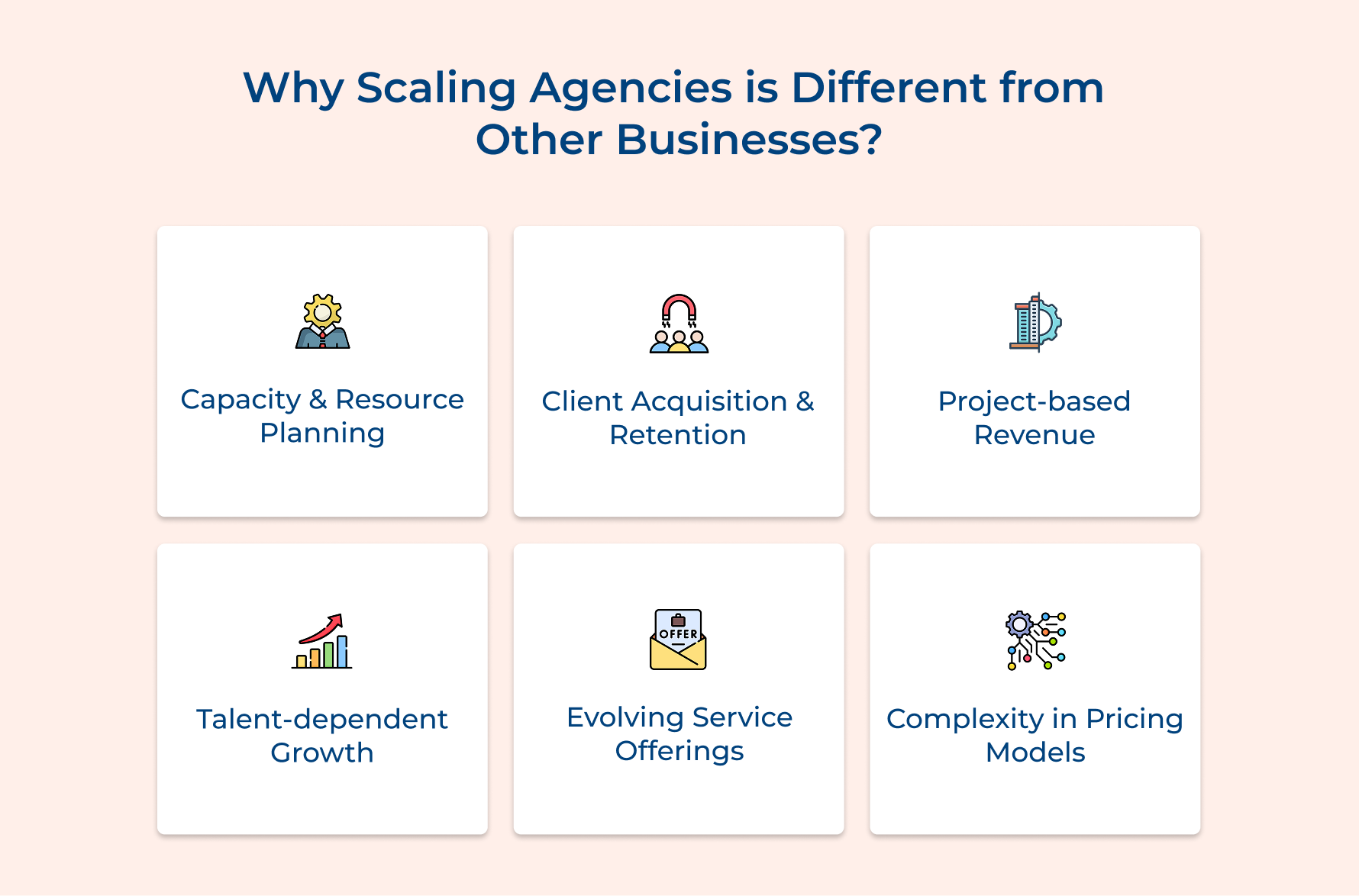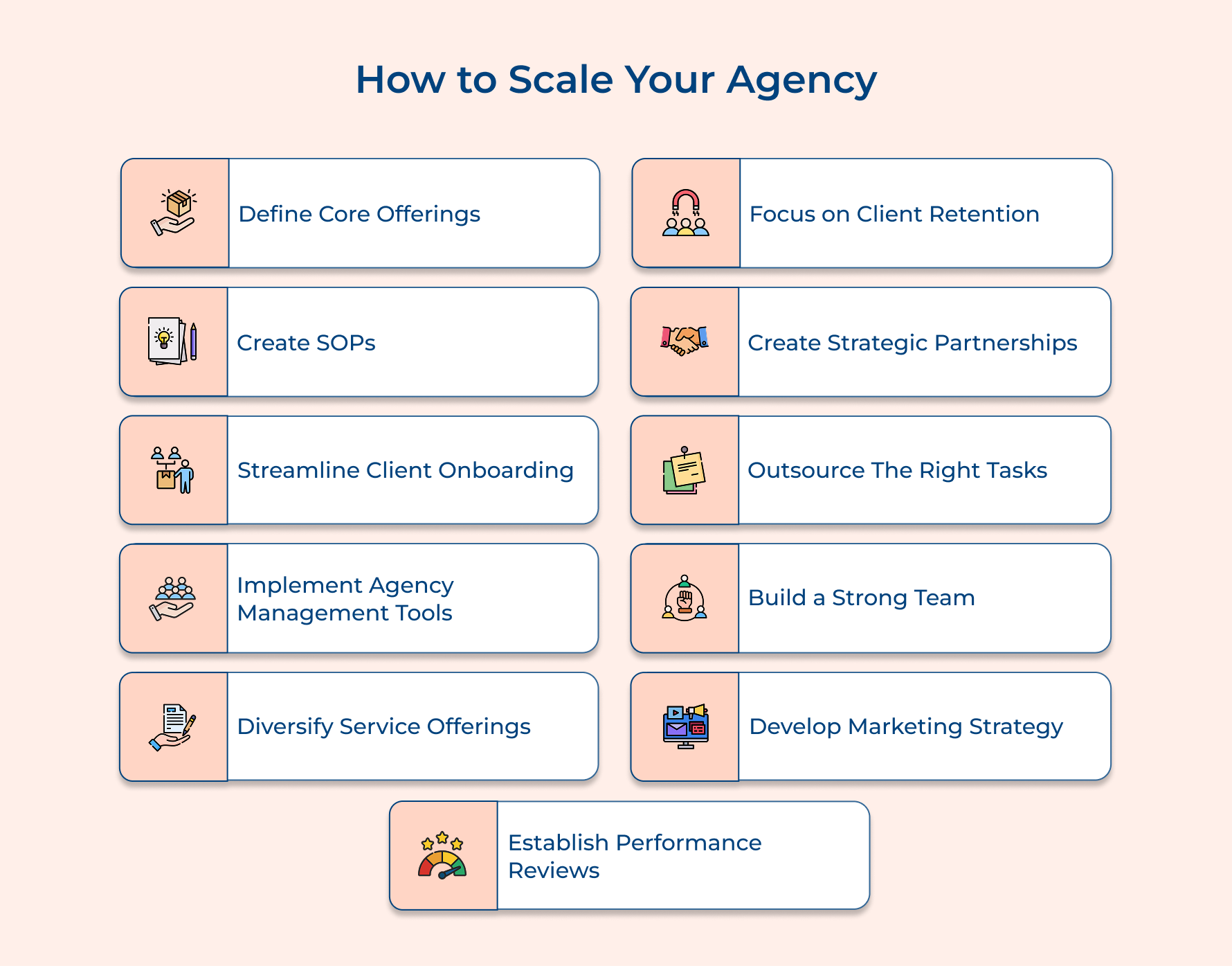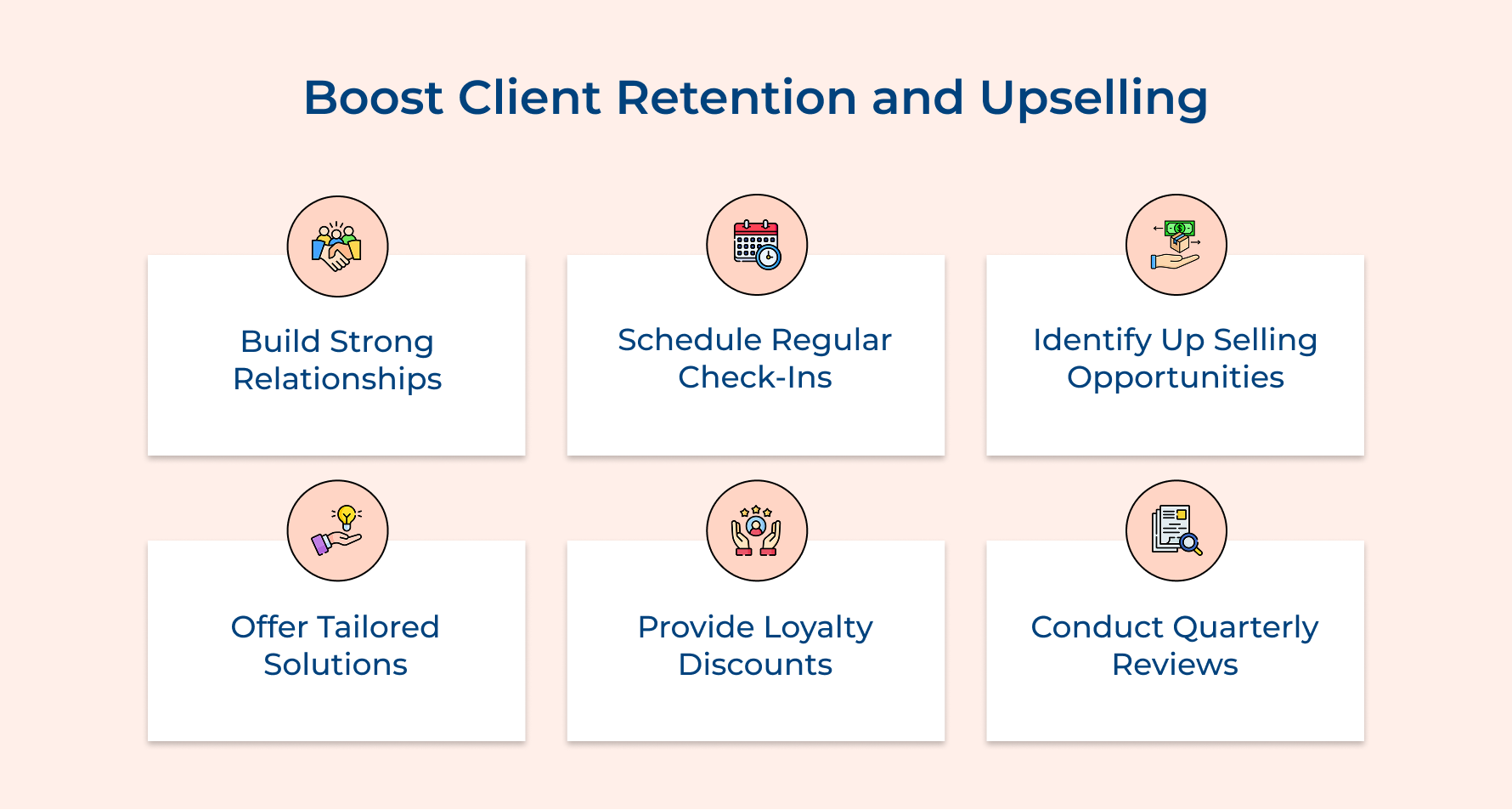11 Proven Steps on How to Scale Agency Effectively
- What is Agency Scaling?
- Why Scaling Agencies is Different from Other Businesses?
- How to Scale Your Agency for Growth: 11 Proven Strategies
- Key Challenges in Agency Scaling (and How to Overcome Them)
- Achieve Scalable Agency Growth with an Effective System in Place
- FAQs about Scaling and Growing the Agency

Key Highlights:
- Scale agency through operational efficiency and automation that handles increased workload without compromising quality.
- Balancing resource allocation and profitability ensures sustainable scaling without financial strain.
- A diversified and consistent sales pipeline is crucial for predictable revenue growth.
Scaling an agency is an exciting journey, but it’s not just about bigger budgets or more clients. It’s about laying the groundwork for sustainable growth while navigating the inevitable challenges that come with expansion.
So, how do you prepare your agency for growth without losing momentum or quality?
Let us explore actionable strategies that go beyond the basics. From refining your workflows to making smart hiring decisions, we’ll share insights to help your agency to not just grow, but thrive!
What is Agency Scaling?
Agency scaling refers to the strategic process of growing a marketing, advertising, or creative agency sustainably and efficiently. It involves expanding the agency’s capabilities, client base, and revenue while maintaining the quality of services.
Scaling goes beyond simply increasing the number of clients or employees; it focuses on creating systems that allow the agency to handle increased demand and complexity without sacrificing performance.
Key objectives:
1. Increase revenue and profitability while maintaining service quality as well as client satisfaction.
2. Develop scalable systems that support efficient growth and consistent service delivery.
3. Build an adaptable team and culture capable of handling increased workload along with complexity.
4. Establish a market position that attracts high-value clients and partnerships, driving sustainable growth.
Why Scaling Agencies is Different from Other Businesses?
Scaling an agency isn’t like scaling other businesses—it comes with its own unique set of hurdles. Let us explore some of its possibilities.
1. Capacity & Resource Planning
Agencies have a unique challenge when it comes to managing capacity and resources. Unlike product-based businesses with predictable production schedules, agency workloads often fluctuate based on client needs. One month you’re swamped, the other time, it’s quiet.
Scaling means figuring out how to handle these peaks and valleys without overstaffing or stretching your team too thin. A smart solution? Building a flexible workforce with a mix of full-timers, freelancers, and contractors to adapt as needed.
2. Client Acquisition & Retention
When it comes to scaling, agencies can’t just focus on landing new clients—it’s equally important to keep existing ones happy and growing.
Client relationships in agencies are more personal and long-term compared to transactional businesses. So, it’s vital to keep showing value, adapting to their evolving needs, while also building trust. A major client walking away can seriously hurt your momentum, so nailing retention strategies is just as important as acquisition.
3. Project-based Revenue
Agencies often rely on project-based work, which can make forecasting revenue and managing cash flow tricky. There’s no guaranteed monthly income, so scaling means more than just signing new projects—you need to make them bigger and more frequent.
Agencies will require sharp project management to juggle multiple large-scale projects without dropping the ball on deadlines or quality. To grow steadily, agencies need a solid pipeline of projects and a plan to smooth out those revenue dips.
4. Talent-dependent Growth
For agencies, growth is directly tied to the people on the team. Unlike product-based businesses that can rely on automation or mass production, agencies depend on their team’s creativity and expertise.
Scaling means hiring more people, yes, but also training them, keeping them motivated, and making sure your culture attracts top talent. It’s a balancing act—grow too fast, you risk losing quality; grow too slow, and you might fall behind.
5. Evolving Service Offerings
Staying relevant in tech and marketing means constantly updating what you offer. Scaling an agency often involves branching out into new services or doubling down on emerging trends. It could mean investing in tools, training, or even new team members.
The tricky part? Balancing the need to specialize with the demand for all-in-one solutions. To scale successfully, agencies need to stay agile and ready to evolve.
6. Complexity in Pricing Models
Pricing agency services is rarely straightforward. Unlike physical products with fixed costs, services are often custom, making it tricky to land on a pricing model that works for both you and your clients.
As you scale, you might need to move beyond hourly rates to retainers or value-based pricing. Getting this right is crucial—not just to stay competitive, but to ensure your growth is sustainable and profitable.
How to Scale Your Agency for Growth: 11 Proven Strategies
Scaling your agency doesn’t have to feel overwhelming. With the right strategies, you can set your agency up for sustainable growth while keeping your clients and team happy.
1. Define Your Agency’s Core Offerings and Customer Personas
Defining your core offerings and ideal customer personas is key to sustainable growth.
Focus on your most profitable services and the clients who value them, streamlining operations while also refining your marketing.
Clear offerings and personas help you stand out in a competitive market as well as attract the right clients.
How to make it more effective?
- Identify strengths: Conduct a team workshop to pinpoint profitable services and ideal clients using past project data.
- Build personas: Document client demographics, goals, and pain points; update regularly.
- Align processes: Tailor marketing messages, refine pricing, and train your team to meet client needs effectively.
2. Create SOPs & Operational Workflows
SOPs and workflows are the backbone of a scalable agency. They ensure consistency, reduce errors, and improve efficiency.
With clear SOPs, you can onboard new team members faster, maintain quality, and free up leadership for strategic growth.
Quick tips that you should consider:
- Document processes: Start with your core services, outlining steps in easy-to-follow flowcharts or guides.
- Assign owners: Designate team members to update SOPs and ensure compliance.
- Automate workflows: Identify tasks that can be automated to save time and boost efficiency.
- Review regularly: Update SOPs to reflect improvements and best practices.
3. Streamline The Client Onboarding Process
When you bring on a new client, that first interaction sets the tone for the entire relationship. Imagine signing a new client for a website redesign.
If your onboarding process is smooth—collecting all the necessary details, setting expectations, and aligning timelines—you’re already building trust and saving time.
On the flip side, a chaotic start could leave clients second-guessing their choice.
How to Make Onboarding More Effective:
- Start with a checklist: Create a step-by-step onboarding guide. For example, include sending a welcome email, a client questionnaire, and a project timeline.
- Use tools: Automate tasks like sending contracts and setting up a client portal for easy updates as well as document sharing.
- Host a kickoff call: Use a structured template to cover goals, timelines, and deliverables—think of it as setting the stage for success.
- Get feedback: After onboarding, ask clients what worked and what could be better to fine-tune the process.
4. Implement Agency Management Tools
Scaling an agency isn’t just about growing your client base; it’s about managing the added complexity that comes with it. This is where agency management tools become your best ally.
These tools not only improve collaboration but also provide clear insights into project profitability and resource allocation.
By automating routine tasks and centralizing workflows, you free up your team’s time to focus on delivering quality work. Tools like these also bring transparency, keeping everyone on the same page.
To get started, explore different agency management tools and try out a few to see what fits your workflow best. Assign a “tool champion”—someone on your team who can lead the implementation, provide training, and ensure everyone uses the tool consistently.
Remember, the key to maximizing these tools is team-wide adoption, so keep the process simple and tailored to your agency’s needs.
5. Diversify Your Service Offerings
Adding new services is a smart way to grow your agency and stay competitive. Imagine you’re a social media agency, and you notice clients asking about content creation or influencer marketing.
Expanding into these areas can help you attract more clients, boost revenue, and reduce dependency on just one service. Plus, it opens up opportunities to cross-sell to current clients, strengthening your relationships.
Start by analyzing market trends and client needs. For example, if short-form video is trending, consider adding video production.
Test the waters with a trusted client—say, offering a pilot project for reels—and use their feedback to refine the service. When ready, bundle your new offerings into packages to make them more appealing.
6. Focus on Client Retention and Upselling
Keeping your clients happy and engaged is much easier (as well as cheaper) than finding new ones. Plus, loyal clients often stick around longer and trust you enough to try additional services.
Here’s how to make client retention and upselling work for you:
1. Nurture relationships:
- Set up a structured account management system.
- Schedule regular check-ins to discuss goals and feedback.
2. Spot upselling opportunities:
- Use data to predict client needs and offer tailored solutions.
- Suggest upgrades, like premium services or extra support, when clients are ready.
3. Incentivize loyalty:
- Offer loyalty discounts or packages for long-term commitments.
- Conduct quarterly reviews to explore how your agency can add more value.
7. Create Strategic Partnerships and Collaborations
Teaming up with the right partners can unlock new opportunities for your agency without heavy investments. From gaining access to new skills to reaching untapped markets, partnerships can help you scale smartly.
1. Find the right fit:
- Look for businesses or freelancers with skills that complement yours.
- Attend industry events and join networks to meet potential collaborators.
2. Start small:
- Begin with low-risk projects to test how well you work together.
- Build trust before committing to bigger collaborations.
3. Leverage partnerships:
- Create referral systems to share clients and resources.
- Co-host events or content to expand your audience reach.
8. Outsource The Right Tasks
Outsourcing can be a game-changer when it comes to scaling your agency. By delegating specialized or non-core tasks, you free up time and resources to focus on what you do best. Adding to the list, it’s a flexible way to handle workload spikes and explore new service areas.
1. Pinpoint what to outsource:
- Identify tasks that are repetitive, non-core, or require specific expertise.
- Consider testing new services through outsourcing before fully committing.
2. Find reliable partners:
- Use freelance platforms or build a roster of trusted contractors.
- Establish clear selection criteria to ensure quality and reliability.
3. Ensure consistency:
- Create detailed briefs and style guides to align outsourced work with your agency’s standards.
- Set up regular check-ins to maintain clear communication and quality control.
9. Build a Strong Team and Company Culture
A great team and a thriving company culture are the backbone of any growing agency. Let’s say that your agency lands a major client project, but without a motivated and collaborative team, meeting tight deadlines could be a challenge.
Now, imagine the same scenario with a team that shares your values, communicates openly, and feels invested in the agency’s success. It’s a game-changer, right?
1. Start with your mission:
- Define clear values and ensure everyone understands them. For example, if “creativity” is a core value, encourage brainstorming sessions and reward innovative ideas.
2. Support your team:
- Provide career development opportunities, like online courses or mentorship programs.
- Celebrate wins—big or small—to boost morale and reinforce positive behavior.
3. Make culture your strength:
- Use it as a selling point for recruiting talent. A vibrant culture attracts the best people and impresses potential clients.
- Check in regularly with anonymous surveys to ensure your team stays happy and engaged.
10. Develop a Robust Sales & Marketing Strategy
A solid sales and marketing strategy is the foundation for growing your agency. Imagine launching a webinar that draws in your ideal clients or landing a dream project because your case studies spoke directly to a prospect’s needs. That’s the power of a well-thought-out approach!
1. Attract the right clients:
- Use a multi-channel marketing strategy that targets your ideal personas.
- Share content like blogs, webinars, or videos that solve their specific problems.
2. Streamline your sales process:
- Implement a structured sales pipeline with clear stages to track progress.
- Use lead scoring to focus on high-potential prospects and personalize follow-ups.
3. Showcase your expertise:
- Use case studies and testimonials to build trust with potential clients.
- Highlight measurable results that showcase your agency’s impact.
11. Establish Business Metrics and Regular Performance Reviews
Keeping a pulse on your agency’s performance ensures you’re heading in the right direction and highlights when something needs attention.
1. Set clear metrics:
- Define key performance indicators (KPIs) for finances, operations, client satisfaction, and team performance.
- Use tools like dashboards or reports to track and visualize these metrics in real time.
2. Review performance regularly:
- Schedule monthly or quarterly review meetings with your core team.
- Analyze progress against goals, identify trends, and discuss challenges.
3. Build team alignment:
- Share relevant metrics with the team to promote transparency and accountability.
- Celebrate wins and use insights to refine strategies that also improve processes.
Key Challenges in Agency Scaling (and How to Overcome Them)
Scaling an agency is exciting but comes with its fair share of hurdles. From managing resources to maintaining quality, let’s explore common challenges and how you can tackle them.
1. Building a Sustainable Client Pipeline
Balancing the acquisition of new clients while managing existing ones can be tricky. To keep things flowing, develop a targeted marketing strategy and use a CRM system to manage leads.
Create valuable content that speaks to your audience’s needs, and encourage satisfied clients to refer others. Building strategic partnerships can also help you maintain a steady flow of leads.
2. Managing Increased Operational Complexity
As your agency grows, managing projects and client relationships becomes more complex. To stay on top, invest in project management tools, standardize processes for building project scope along with its execution and client communication. Consider adopting agile methodologies for flexibility.
3. Plan & Allocate Resources Effectively
Balancing resources across multiple projects can be tough, especially with growth on the horizon.
Use resource management software to track team capacity and prioritize projects based on their strategic importance. Creating a flexible staffing model with full-time employees, contractors, and freelancers allows you to scale without overwhelming your team.
4. Managing Client Churn and Retainers
Client retention is essential for stable revenue, but scaling can sometimes lead to client churn. To reduce this risk, focus on delivering consistent value, implement a solid account management system, and offer flexible retainer packages.
5. Maintaining Quality While Scaling
Ensuring consistent quality can always be a challenge. To keep standards high, develop style guides and quality control processes, as well as implement peer reviews for all deliverables.
Invest in ongoing team training, and use project management tools to track quality. Regular client feedback is crucial for identifying areas that need improvement.
6. Attracting and Retaining Top Talent
The competition for skilled professionals is fierce. Attract the best by creating an employer brand that emphasizes company culture, career growth, as well as work-life balance.
Offer competitive compensation and clear career progression, along with professional development opportunities. Flexible work arrangements can also help attract top talent.
Achieve Scalable Agency Growth with an Effective System in Place
Scaling an agency successfully hinges on four critical pillars: a strong sales pipeline, operational efficiency, effective resource management, and maintaining profitability. These elements are necessary because they form the foundation for sustainable growth, ensuring a steady influx of clients, smooth execution of projects, and healthy financial performance.
To achieve this balanced scaling, agencies must focus on developing robust marketing and sales strategies, adopting flexible resource allocation models, while maintaining a keen eye on financial metrics. It requires a holistic approach that aligns all aspects of the agency’s operations with its growth objectives.
Limit time — not creativity
Everything you need for customer support, marketing & sales.
Neeti Singh is a passionate content writer at Kooper, where he transforms complex concepts into clear, engaging and actionable content. With a keen eye for detail and a love for technology, Tushar Joshi crafts blog posts, guides and articles that help readers navigate the fast-evolving world of software solutions.


